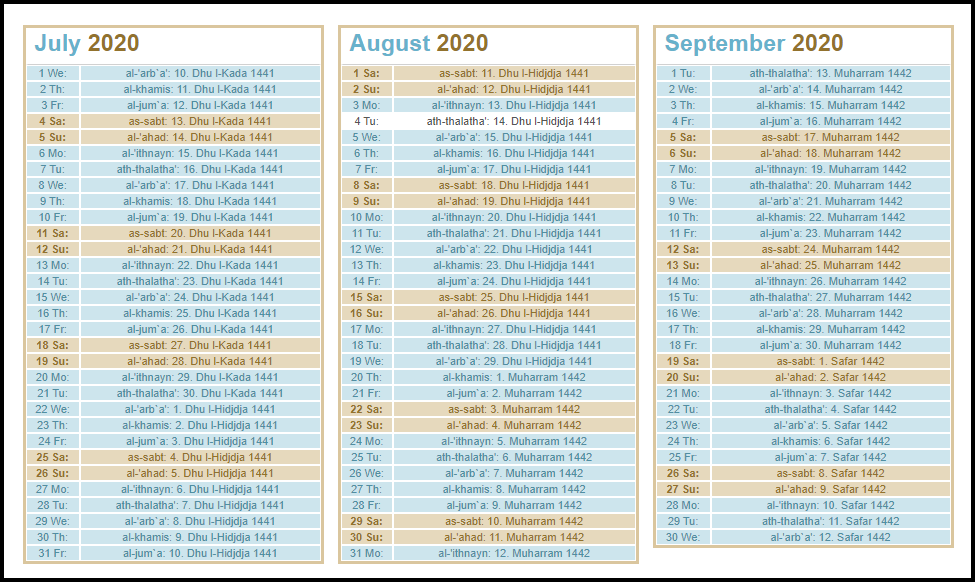

The forbidden months were four months during which fighting is forbidden, listed as Rajab and the three months around the pilgrimage season, Dhu al-Qa‘dah, Dhu al-Hijjah, and Muharram. The Islamic tradition is unanimous in stating that Arabs of Tihamah, Hejaz, and Najd distinguished between two types of months, permitted ( ḥalāl) and forbidden ( ḥarām) months. Both al-Biruni and al-Mas'udi suggest that the ancient Arabs used the same month names as the Muslims, though they also record other month names used by the pre-Islamic Arabs. At least some of these South Arabian calendars followed the lunisolar system. Inscriptions of the ancient South Arabian calendars reveal the use of a number of local calendars. Historyįor central Arabia, especially Mecca, there is a lack of epigraphical evidence but details are found in the writings of Muslim authors of the Abbasid era. In the Gregorian calendar reckoning, 1444 AH runs from approximately 30 July 2022 to 18 July 2023. Īs of 30 July 2022 CE, the current Islamic year is 1444 AH. In English, years prior to the Hijra are denoted as BH ("Before the Hijra"). In Muslim countries, it is also sometimes denoted as H from its Arabic form ( سَنَة هِجْرِيَّة, abbreviated ھ). In the West, dates in this era are usually denoted AH ( Latin: Anno Hegirae, "in the year of the Hijrah"). During that year, Muhammad and his followers migrated from Mecca to Medina and established the first Muslim community ( ummah), an event commemorated as the Hijrah. This calendar enumerates the Hijri era, whose epoch was established as the Islamic New Year in 622 CE. In almost all countries where the predominant religion is Islam, the civil calendar is the Gregorian calendar, with Syriac month-names used in the Levant and Mesopotamia ( Iraq, Syria, Jordan, Lebanon and Palestine) but the religious calendar is the Hijri one. It is used to determine the proper days of Islamic holidays and rituals, such as the annual fasting and the annual season for the great pilgrimage. The Hijri calendar ( Arabic: ٱلتَّقْوِيم ٱلْهِجْرِيّ, romanized: al-taqwīm al-hijrī), also known in English as the Muslim calendar and Islamic calendar, is a lunar calendar consisting of 12 lunar months in a year of 354 or 355 days.

As well, since the traditional Hijri calendar is observational instead of mathematical (based on when phases of the moon can be seen) the start dates aren't always perfectly predictable.Islamic calendar stamp issued at King Khalid International Airport on 10 Rajab 1428 AH (24 July 2007 CE) There are a few different versions, such as the Solar Hijri calendar used in Iran (which is a solar calendar) and the Tabular Hijri calendar (which is mathematically derived, much like how Jewish calendar was changed in the past).ĭue to how the Hijri calendar rotates, the Hijri years are given as well to help clarify the chronology of events relative to the Gregorian calendar. The Hijri year is usually ten days shorter than the Gregorian year. The Hijri calendar is named for the Hijra (or Hegira), the Prophet Muhammad's flight from Mecca to Medina to escape persecution. These holidays move in the Western ( Gregorian) calendar year since the Islamic (or Hijri) calendar is a lunar calendar, instead of a solar calendar. Here are the dates of the most important Islamic holidays through 2030.


 0 kommentar(er)
0 kommentar(er)
